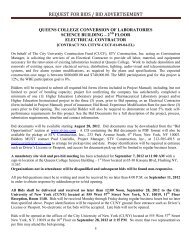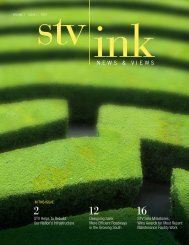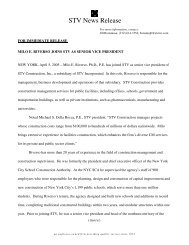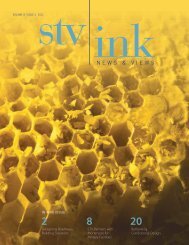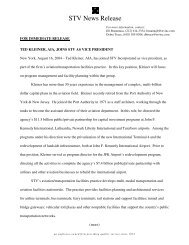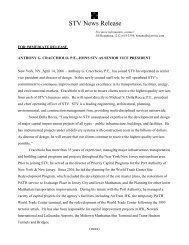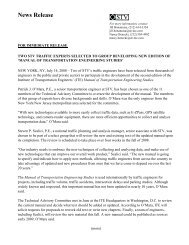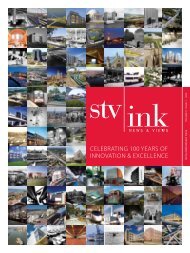Designing New and Improved Facilities for the ... - STV Group, Inc.
Designing New and Improved Facilities for the ... - STV Group, Inc.
Designing New and Improved Facilities for the ... - STV Group, Inc.
You also want an ePaper? Increase the reach of your titles
YUMPU automatically turns print PDFs into web optimized ePapers that Google loves.
VOLUME 7 ISSUE 2 2010<br />
In This Issue<br />
2<br />
<strong>STV</strong> Will Provide Construction<br />
Management Services <strong>for</strong> a<br />
<strong>New</strong> Police Academy in NYC<br />
8 18<br />
<strong>Designing</strong> <strong>New</strong> <strong>and</strong><br />
<strong>Improved</strong> <strong>Facilities</strong><br />
<strong>for</strong> <strong>the</strong> USDA<br />
A Look Back at <strong>the</strong><br />
Past Century of <strong>STV</strong><br />
stv | ink 1
table of<br />
contents<br />
2<br />
VOLUME 7 | ISSUE 2 | 2010<br />
<strong>STV</strong> <strong>Group</strong><br />
205 West Welsh Drive<br />
Douglassville, PA 19518<br />
T 610-385-8200<br />
F 610-385-8500<br />
<strong>STV</strong> <strong>Inc</strong>orporated<br />
225 Park Avenue South<br />
<strong>New</strong> York, NY 10003<br />
T 212-777-4400<br />
F 212-529-5237<br />
info@stvinc.com<br />
www.stvinc.com<br />
8 12<br />
Editorial Board<br />
Dominick M. Serevdio, P.E.<br />
Chairman &<br />
Chief Executive Officer<br />
Milo E. Riverso, Ph.D., P.E.<br />
President<br />
Linda Rosenberg<br />
Senior Vice President<br />
Marketing & Communications<br />
Richard M. Amodei<br />
Senior Vice President<br />
Thomas J. Madison<br />
Vice President<br />
Director of<br />
Transportation Policy<br />
Bruce D. Eisenberg<br />
AIA, LEED® AP<br />
Vice President<br />
Director of<br />
Architectural Studios<br />
Managing Editors<br />
Debra Trace<br />
Jill Bonamusa<br />
Editor<br />
Mark Ginocchio<br />
Contributors<br />
Nancy Benecki<br />
Jennifer Callahan<br />
Rachel Spevack<br />
Graphic Design<br />
Whitney Plant<br />
Front cover photo:<br />
© Sebastian Kaulitzki/Shutterstock<br />
2 stv | ink<br />
14<br />
1<br />
Prioritizing Safety<br />
A large portion of <strong>STV</strong>’s project portfolio<br />
not only focuses on improving public<br />
services, but also prioritizing enhanced<br />
public safety.<br />
2<br />
Empire State Peace of Mind:<br />
<strong>STV</strong> Will Provide Construction<br />
Management Services <strong>for</strong> a <strong>New</strong> Police<br />
Academy in <strong>New</strong> York City<br />
A new state-of-<strong>the</strong>-art training facility<br />
<strong>for</strong> <strong>the</strong> <strong>New</strong> York City Police<br />
Department is underway, <strong>and</strong> <strong>STV</strong><br />
will provide construction management<br />
services in a joint venture to see <strong>the</strong><br />
project to completion.<br />
5<br />
Greening <strong>the</strong> Big Apple<br />
Patricia Z<strong>and</strong>er is working to<br />
make <strong>the</strong> new Police Academy meet<br />
greener st<strong>and</strong>ards.<br />
18<br />
20<br />
6<br />
Time is of <strong>the</strong> Essence on<br />
BRAC Projects:<br />
Collaborating on Five Design-Build<br />
BRAC Projects<br />
By providing design services <strong>for</strong> five<br />
design-build facilities <strong>for</strong> <strong>the</strong> U.S. Army<br />
Corps of Engineers, <strong>STV</strong> is playing a<br />
key role with <strong>the</strong> Base Realignment <strong>and</strong><br />
Closure program.<br />
8<br />
Let There Be Life Sciences:<br />
<strong>Designing</strong> <strong>New</strong> <strong>and</strong> <strong>Improved</strong> <strong>Facilities</strong><br />
<strong>for</strong> <strong>the</strong> USDA<br />
<strong>STV</strong> has a long history designing new<br />
facilities <strong>and</strong> upgrading current ones <strong>for</strong> <strong>the</strong><br />
United States Department of Agriculture.<br />
9<br />
Preparing Pennsylvania:<br />
<strong>New</strong> BSL-3 Lab in <strong>the</strong> Keystone State<br />
A new veterinary laboratory designed by<br />
<strong>STV</strong> has opened in Pennsylvania.
Prioritizing Safety<br />
The public’s right to safety is an ideal that can be traced back <strong>for</strong><br />
centuries. Even <strong>the</strong> Constitution of <strong>the</strong> United States lists “safety”<br />
as an unalienable right. A large portion of <strong>STV</strong>’s project portfolio<br />
not only focuses on improving public services, but also prioritizing<br />
enhanced public safety.<br />
In <strong>the</strong> past decade, <strong>the</strong>re has been a renewed commitment by<br />
<strong>the</strong> U.S. government to enhance <strong>the</strong> nation’s safety <strong>and</strong> defense.<br />
Billions of dollars have been dedicated towards providing modernized<br />
facilities <strong>and</strong> technology that not only enhances <strong>the</strong> country’s<br />
physical strength, but also ensures more protection <strong>for</strong> <strong>the</strong> nation’s<br />
food supply <strong>and</strong> better peace of mind <strong>for</strong> users of mass transit. <strong>STV</strong><br />
continues to work closely with our clients to help brea<strong>the</strong> life into<br />
<strong>the</strong>se critical initiatives.<br />
12<br />
Keeping Railroads on a<br />
Positive Route<br />
A federal m<strong>and</strong>ate to upgrade <strong>the</strong><br />
safety systems on <strong>the</strong> nation’s railroad<br />
network has brought <strong>STV</strong> <strong>and</strong> <strong>the</strong><br />
Sou<strong>the</strong>astern Pennsylvania Transportation<br />
Authority toge<strong>the</strong>r.<br />
13<br />
Security <strong>for</strong> Amtrak<br />
On Track<br />
<strong>STV</strong> is providing security design services at<br />
shops, stations <strong>and</strong> o<strong>the</strong>r Amtrak facilities<br />
across <strong>the</strong> country.<br />
14<br />
Simulation Observations:<br />
<strong>STV</strong>’s Cali<strong>for</strong>nia, MD, Office Provides<br />
Critical Research <strong>and</strong> Development<br />
<strong>for</strong> <strong>the</strong> Military<br />
<strong>STV</strong> has played a historically pivotal role in<br />
protecting U.S. Naval aircrew personnel.<br />
16<br />
Jet Test:<br />
One of <strong>the</strong> Few Firms to Design<br />
Jet Engine Test <strong>Facilities</strong><br />
Jet engine test cells are complicated<br />
facilities, but <strong>STV</strong> is one of <strong>the</strong> few firms<br />
that specializes in designing <strong>the</strong>m.<br />
18<br />
A Place in History:<br />
A Look Back at <strong>the</strong> Past Century of <strong>STV</strong><br />
<strong>STV</strong>’s roots in defense <strong>and</strong> safety work go<br />
back nearly 70 years.<br />
20<br />
<strong>STV</strong> Gives Back:<br />
A Look at <strong>STV</strong> <strong>and</strong> <strong>the</strong> Communities<br />
We Serve<br />
<strong>STV</strong>’s experienced architects, engineers<br />
<strong>and</strong> construction managers mentor <strong>the</strong><br />
industry’s next generation.<br />
21<br />
In Remembrance of<br />
Maher Labib<br />
Maher Labib, executive vice president<br />
<strong>and</strong> chief operating officer of <strong>the</strong> firm’s<br />
Buildings & <strong>Facilities</strong> Division, passes<br />
away at 67.<br />
22<br />
What’s <strong>New</strong> at <strong>STV</strong><br />
<strong>STV</strong> welcomes Civil Structures <strong>Inc</strong>., is<br />
recognized in three states by <strong>the</strong> American<br />
Council of Engineering Companies, opens<br />
a new office in Orl<strong>and</strong>o, FL, <strong>and</strong> more.<br />
stv | ink 1
Empire State Peace of Mind<br />
<strong>STV</strong> Will Provide Construction Management Services <strong>for</strong> a<br />
<strong>New</strong> Police Academy in <strong>New</strong> York City<br />
2 stv | ink
As <strong>the</strong> largest police <strong>for</strong>ce in <strong>the</strong> United States, <strong>the</strong> <strong>New</strong> York City<br />
Police Department (NYPD) has <strong>the</strong> enormous responsibility of<br />
keeping <strong>the</strong> Big Apple safe. So, it’s only fitting that <strong>New</strong> York’s<br />
finest should get a new state-of-<strong>the</strong>-art training facility to help<br />
prepare <strong>the</strong>m <strong>for</strong> <strong>the</strong>ir always-evolving duty to serve <strong>and</strong> protect.<br />
Rendering: Perkins + Will * Michael Fieldman Architects<br />
“The new academy will vastly improve<br />
<strong>the</strong> officer training that goes into<br />
making <strong>the</strong> NYPD <strong>the</strong> world’s greatest<br />
<strong>and</strong> most advanced police department<br />
by providing a state-of-<strong>the</strong>-art facility<br />
that can serve <strong>the</strong> department’s 21st<br />
century needs,” <strong>New</strong> York City Mayor<br />
Michael R. Bloomberg said at <strong>the</strong><br />
groundbreaking ceremony.<br />
<strong>STV</strong>/Turner, a joint venture of <strong>STV</strong><br />
<strong>and</strong> Turner Construction Company,<br />
is providing pre-construction, construction<br />
<strong>and</strong> post-construction services,<br />
which includes procuring contracts, <strong>and</strong><br />
<strong>New</strong> Police Academy view from 28th Avenue<br />
looking Southwest<br />
managing <strong>and</strong> supervising all construction<br />
work. The joint venture partners<br />
will also provide all construction<br />
management services <strong>for</strong> <strong>the</strong> inspection,<br />
supervision, management, coordination<br />
<strong>and</strong> administration of <strong>the</strong> project.<br />
Because <strong>the</strong> project is phased, <strong>and</strong> <strong>the</strong>re<br />
are various sensitivities involved in<br />
building a new police academy, <strong>STV</strong>/<br />
Turner is providing guidance on <strong>the</strong><br />
design documents <strong>and</strong> creating a phasing<br />
plan so schedules work as effectively<br />
<strong>and</strong> efficiently as possible.<br />
stv | ink 3
<strong>New</strong> York City officials<br />
break ground at <strong>the</strong> site of<br />
<strong>the</strong> police academy.<br />
Training <strong>and</strong> education <strong>for</strong> officers<br />
has long been a priority <strong>for</strong> <strong>the</strong> NYPD.<br />
Officer recruits undergo a rigorous<br />
<strong>and</strong> comprehensive six-month training<br />
program to become one of <strong>New</strong> York<br />
City’s “Finest,” <strong>and</strong> active officers<br />
must receive additional training on<br />
a regular basis.<br />
The rigors of this regimen have put<br />
a strain on <strong>the</strong> department’s existing<br />
facilities. An assessment of <strong>the</strong> NYPD’s<br />
current training sites revealed aging,<br />
outdated spaces scattered across <strong>the</strong> city<br />
that would be adequate <strong>for</strong> a department<br />
half <strong>the</strong> size of <strong>the</strong> current <strong>for</strong>ce.<br />
The need <strong>for</strong> a new, world-class NYPD<br />
training facility was becoming more<br />
evident every day.<br />
The new 70,000-square-foot facility will<br />
consolidate all of <strong>the</strong> NYPD’s training<br />
functions in one location, <strong>and</strong> will<br />
house up to 2,000 recruits at a time <strong>for</strong><br />
training. The first phase will include a<br />
physical training building, with a 1/8-<br />
mile running track <strong>and</strong> special tactical<br />
gymnasium, <strong>and</strong> an academic building<br />
with classroom space <strong>for</strong> more than 300<br />
recruits, library space, administrative<br />
<strong>and</strong> faculty offices, <strong>and</strong> mock environment<br />
rooms <strong>for</strong> immersion training.<br />
Subsequent phases will include a new<br />
firing range, a tactical training village<br />
<strong>and</strong> a vehicle training course.<br />
Immersion <strong>and</strong> scenario-based training<br />
is <strong>the</strong> way <strong>the</strong> NYPD will conduct<br />
much of its future training, according<br />
Rendering: Perkins + Will * Michael Fieldman Architects<br />
4 stv | ink
to Michael Plottel, AIA, project executive<br />
<strong>for</strong> <strong>the</strong> DDC <strong>and</strong> project manager<br />
<strong>for</strong> <strong>the</strong> entire police academy project.<br />
“Scenario-based <strong>and</strong> immersion<br />
training gives <strong>the</strong> NYPD ano<strong>the</strong>r<br />
level of realism,” Plottel said. “It is very<br />
effective in duplicating <strong>the</strong> various<br />
situations officers will encounter on<br />
<strong>the</strong> streets, <strong>and</strong> sessions can be videotaped<br />
so recruits can get feedback<br />
on <strong>the</strong>ir reactions.”<br />
Situations that <strong>the</strong> NYPD will be<br />
able to simulate as <strong>the</strong> new police<br />
academy progresses include traffic<br />
stops, various neighborhood settings,<br />
subway stations <strong>and</strong> more.<br />
And <strong>the</strong> integrated project office in<br />
Manhattan, which houses employees<br />
from <strong>STV</strong> <strong>and</strong> Turner, <strong>the</strong> DDC <strong>and</strong><br />
NYPD, has been heralded as a plus<br />
<strong>for</strong> <strong>the</strong> project.<br />
“It’s a trans<strong>for</strong>mative way to how this<br />
project is being developed,” Plottel<br />
said. “Milestones are being blurred<br />
because of <strong>the</strong> benefits of having<br />
construction management, owners,<br />
architects <strong>and</strong> engineers in <strong>the</strong> same<br />
office. We can look at in<strong>for</strong>mation in<br />
real time. Old mindsets are definitely<br />
starting to change.”<br />
Daniel Reddan, <strong>STV</strong> vice president<br />
<strong>and</strong> project executive <strong>for</strong> <strong>the</strong> police<br />
academy, agrees that <strong>the</strong> project office<br />
is having a positive effect.<br />
“Everyone working on <strong>the</strong> project is<br />
right here,” Reddan said. “If we ask<br />
a question, we get quick responses.<br />
Everyone is working well toge<strong>the</strong>r.”<br />
Aerial rendering<br />
of <strong>the</strong> new NYPD<br />
Police Academy.<br />
Greening <strong>the</strong><br />
Big Apple<br />
Patricia Z<strong>and</strong>er, P.E., LEED® AP, is working towards making a<br />
greener <strong>New</strong> York City. She is a project manager with <strong>STV</strong> <strong>and</strong> <strong>the</strong><br />
LEED compliance officer <strong>for</strong> <strong>the</strong> firm’s work on <strong>the</strong> state-of-<strong>the</strong>art<br />
police academy <strong>for</strong> <strong>the</strong> <strong>New</strong> York City Police Department. In<br />
2008, she was selected by <strong>the</strong> U.S. Green Building Council (USGBC)<br />
to participate on <strong>the</strong> <strong>New</strong> York City Green Codes Task Force. The<br />
group conducted a comprehensive review of <strong>the</strong> city’s building<br />
<strong>and</strong> construction codes <strong>and</strong> made more than 100 recommendations<br />
to boost <strong>the</strong>ir sustainability.<br />
The NYC Green Codes Task Force was created by <strong>New</strong> York City<br />
Mayor Michael Bloomberg <strong>and</strong> City Council Speaker Christine<br />
Quinn as part of PlaNYC, a sweeping initiative to improve <strong>the</strong> city’s<br />
waterways, provide cleaner <strong>and</strong> more reliable power, improve air<br />
quality, <strong>and</strong> reduce greenhouse gas emissions.<br />
Z<strong>and</strong>er sits on <strong>the</strong> task <strong>for</strong>ce’s Site <strong>and</strong> Site Storm Water Technical<br />
Committee, which has a total of 11 people. One issue she examined<br />
was green roofs <strong>and</strong> blue roofs, particularly <strong>the</strong> benefits <strong>and</strong> costs<br />
of each kind of roof, as well as potential structural concerns. Blue<br />
roofs store water, particularly rain water, where it can be reused <strong>for</strong><br />
irrigation, recreational purposes, or to cool a building. Green roofs<br />
feature plant life <strong>and</strong> can serve as a habitat <strong>for</strong> wildlife.<br />
As <strong>for</strong> her work on <strong>the</strong> police academy, Z<strong>and</strong>er said <strong>the</strong> facility is<br />
being built on a <strong>for</strong>mer l<strong>and</strong>fill that was paved over <strong>and</strong> used <strong>for</strong><br />
parking. She is looking to per<strong>for</strong>m an environmentally-responsible<br />
cleanup at <strong>the</strong> site.<br />
“This is not a pristine site. This site saw some controlled <strong>and</strong> uncontrolled<br />
l<strong>and</strong> filling operations in <strong>the</strong> past,” she said. “It’s typical urban<br />
redevelopment. We need to think about incorporating options to<br />
minimize <strong>the</strong> environmental footprint of cleanup actions, which is<br />
a priority of PlaNYC.”<br />
stv | ink 5
Time is of <strong>the</strong> Essence on<br />
Projects<br />
Collaborating on Five Design-Build BRAC Projects<br />
Deadlines are tight <strong>and</strong> <strong>the</strong> scope is huge <strong>for</strong> <strong>the</strong> U.S. Army’s<br />
Base Realignment <strong>and</strong> Closure (BRAC) program. <strong>STV</strong> is playing a<br />
key role in this major initiative, which will allow <strong>the</strong> U.S. Department<br />
of Defense (DOD) to operate <strong>and</strong> maintain its facilities more<br />
efficiently while improving fighting capabilities <strong>and</strong> <strong>the</strong> quality of<br />
life <strong>for</strong> military <strong>for</strong>ces.<br />
As <strong>the</strong> design partner <strong>for</strong> five design-build BRAC projects, <strong>STV</strong> is keenly<br />
aware of <strong>the</strong> strict schedules <strong>and</strong> deadlines <strong>the</strong> program entails. “Each<br />
project has a very specific schedule that is monitored closely by <strong>the</strong> U.S.<br />
Army Corps of Engineers (USACE) <strong>and</strong> <strong>the</strong> user groups,” said Senior Vice<br />
President James Vilbert, P.E., LEED® AP, director of operations, <strong>for</strong> <strong>the</strong><br />
central <strong>and</strong> branch offices <strong>for</strong> <strong>STV</strong>’s Buildings & <strong>Facilities</strong> Division. “In<br />
<strong>the</strong> case of <strong>the</strong> Armed Forces Reserve Centers (AFRCs), <strong>the</strong> users are <strong>the</strong><br />
United States Army Reserve (USAR) <strong>and</strong> National Guard units who will<br />
utilize <strong>the</strong>se facilities <strong>for</strong> training.”<br />
In some instances, <strong>the</strong> USACE is requiring <strong>the</strong>se facilities to be<br />
completed <strong>and</strong> occupied in less than two years — which includes<br />
design, permitting, construction, commissioning <strong>and</strong> start-up. “That’s<br />
aggressive,” Vilbert said.<br />
And with more contractors turning towards <strong>the</strong> federal government<br />
<strong>for</strong> work in a down economy, <strong>the</strong> competition <strong>for</strong><br />
BRAC projects is very intense. “We’ve been doing this <strong>for</strong><br />
over four years <strong>and</strong> have an established group of experienced<br />
build partners that provides us with a competitive advantage<br />
while pursuing design-build work in this sector,”<br />
Vilbert said.<br />
Armed Forces Reserve Center, <strong>New</strong>ark, DE<br />
6 stv | ink
The purpose of <strong>the</strong> BRAC program is to close excess<br />
military installations <strong>and</strong> realign those assets with current<br />
<strong>and</strong> new installations in an ef<strong>for</strong>t to reduce costs. The<br />
most current round of BRAC closings <strong>and</strong> installations<br />
was authorized by <strong>the</strong> U.S. Congress in 2005.<br />
As part of <strong>the</strong> 2005 program, <strong>STV</strong> is providing design<br />
services as a subcontractor <strong>for</strong> three AFRCs located in<br />
Lewisburg, PA, Scranton, PA, <strong>and</strong> <strong>New</strong>ark, DE. <strong>STV</strong><br />
work includes all architectural design <strong>and</strong> engineering<br />
services, such as interior design, civil, structural, mechanical,<br />
electrical, plumbing <strong>and</strong> fire protection.<br />
“These projects are very important in providing stateof-<strong>the</strong><br />
art training facilities <strong>for</strong> <strong>the</strong> U.S. Army Reserve<br />
<strong>and</strong> National Guard units,” said <strong>STV</strong> Federal Programs<br />
Manager Cindy Manning, P.E., LEED® AP.<br />
Completing <strong>the</strong>se facilities by <strong>the</strong> m<strong>and</strong>ated September<br />
15, 2011, deadline requires constant communication <strong>and</strong><br />
collaboration among <strong>the</strong> USACE, <strong>the</strong> users, <strong>the</strong> designbuild<br />
partner <strong>and</strong> <strong>STV</strong>, Manning added.<br />
<strong>STV</strong> has also been charged with <strong>the</strong> delicate balance of<br />
designing buildings that meet <strong>the</strong> requirements set by <strong>the</strong><br />
U.S. military, while also fitting in with <strong>the</strong> surrounding<br />
environment. “Since <strong>the</strong>se are st<strong>and</strong>alone facilities, <strong>the</strong><br />
AFRCs have to con<strong>for</strong>m to <strong>the</strong> local community <strong>and</strong><br />
permitting requirements, <strong>and</strong> still maintain all of <strong>the</strong><br />
antiterrorism <strong>for</strong>ce protection requirements,” Vilbert<br />
said. “You have to make <strong>the</strong> new complex fit into <strong>the</strong><br />
local community so it’s an asset to <strong>the</strong> community <strong>and</strong><br />
not a detriment. The USACE might dictate <strong>the</strong> basic<br />
materials, but it’s up to <strong>the</strong> architect to turn that into<br />
an attractive architectural design.”<br />
In addition to <strong>the</strong> AFRC projects, <strong>STV</strong> is providing<br />
full architectural-engineering design services <strong>for</strong> <strong>the</strong><br />
new United States Military Academy Preparatory<br />
School campus at West Point, NY. As part of <strong>the</strong><br />
BRAC program, <strong>the</strong> existing preparatory school in Fort<br />
Monmouth, NJ, is being closed. The new campus at<br />
West Point has to be completed prior to <strong>the</strong> closing<br />
of <strong>the</strong> existing school, said <strong>STV</strong> Project Manager Price<br />
Jepsen, AIA, LEED® AP. The 256,000-square-foot<br />
campus will encompass 20 acres. <strong>STV</strong> designed <strong>the</strong><br />
various facilities to meet <strong>the</strong> requirements <strong>for</strong> LEED<br />
(Leadership in Energy <strong>and</strong> Environmental Design)<br />
Gold certification. In a two-phased construction<br />
process, barracks <strong>for</strong> housing, a dining facility <strong>and</strong> one<br />
of <strong>the</strong> gymnasiums will be built during <strong>the</strong> first phase,<br />
<strong>and</strong> an academic building, an indoor athletic facility,<br />
<strong>and</strong> additional outdoor sports fields will be built<br />
during <strong>the</strong> second.<br />
Senior Vice President Thomas Anderson, P.E., R.A.,<br />
principal-in-charge of <strong>the</strong> preparatory school campus<br />
project, said “<strong>the</strong> BRAC funding has set <strong>the</strong> aggressive<br />
schedule. The project is being funded by BRAC <strong>for</strong> <strong>the</strong><br />
first phase of construction <strong>and</strong> regular DOD funding<br />
<strong>for</strong> <strong>the</strong> second phase.”<br />
The fifth design-build project that is currently part<br />
of <strong>STV</strong>’s BRAC portfolio is a 109,000-square-foot<br />
munition <strong>and</strong> explosive ordnance disposal training<br />
facility <strong>and</strong> a one-story 11,200-square-foot robotics<br />
training building in Fort Lee, VA. <strong>STV</strong> is <strong>the</strong><br />
architect <strong>and</strong> engineer-of-record <strong>for</strong> <strong>the</strong> project,<br />
which began in October <strong>and</strong> is scheduled to be<br />
completed in February 2011.<br />
Armed Forces Reserve Center, Lewisburg, PA (left)<br />
Training Facility, Fort Lee, VA (right)<br />
stv | ink 7
Let There Be<br />
Life Sciences<br />
<strong>Designing</strong> <strong>New</strong> <strong>and</strong> <strong>Improved</strong><br />
<strong>Facilities</strong> <strong>for</strong> <strong>the</strong> USDA<br />
Photo © Dale Photography <strong>Inc</strong>.<br />
Photo courtesy of <strong>the</strong> USDA<br />
Photo courtesy of <strong>the</strong> USDA<br />
For nearly two decades, <strong>STV</strong><br />
has played an instrumental role<br />
supporting <strong>the</strong> United States<br />
Department of Agriculture’s<br />
(USDA) mission protecting <strong>the</strong><br />
nation’s plant <strong>and</strong> animal supply from<br />
disease <strong>and</strong> infestation.<br />
<strong>STV</strong> has provided a full range of<br />
architectural, engineering <strong>and</strong><br />
construction oversight services across<br />
<strong>the</strong> United States, including Hawaii,<br />
<strong>for</strong> <strong>the</strong> USDA’s Animal <strong>and</strong> Plant<br />
Health Inspection Services<br />
(APHIS) <strong>and</strong> Agricultural Research<br />
Service (ARS) divisions.<br />
Both organizations provide vital services<br />
that impact <strong>the</strong> health of all Americans,<br />
as well as <strong>the</strong> country’s natural environment.<br />
ARS facilities help promote <strong>the</strong><br />
nation’s agricultural health, defending<br />
against potential outbreaks of devastating<br />
diseases like foot-<strong>and</strong>-mouth<br />
disease <strong>and</strong> avian influenza. APHIS<br />
facilities focus on more than a thous<strong>and</strong><br />
research projects dealing with human<br />
nutrition, food safety, crop production,<br />
invasive pest control <strong>and</strong> bioenergy, as<br />
well as o<strong>the</strong>r topics.<br />
<strong>STV</strong>’s work has varied in size <strong>and</strong> scope,<br />
from small repairs <strong>and</strong> renovations to<br />
new construction of very large facilities.<br />
Design services have been <strong>for</strong> a wide<br />
range of facility types, including administrative<br />
spaces, waste pretreatment<br />
centers, <strong>and</strong> Biosafety Level (BSL) 2, 3<br />
<strong>and</strong> 3-Ag laboratories. The BSL-3 <strong>and</strong><br />
3-Ag labs house potentially dangerous<br />
<strong>and</strong> exotic agents.<br />
These <strong>STV</strong>-designed facilities have<br />
helped USDA with <strong>the</strong>ir research on<br />
such vital projects as <strong>the</strong> potential<br />
extinction of <strong>the</strong> honey bee population,<br />
8 stv | ink
Preparing Pennsylvania<br />
<strong>New</strong> BSL-3 Lab in <strong>the</strong> Keystone State<br />
A new BSL-3 Veterinary Laboratory <strong>for</strong> <strong>the</strong> Pennsylvania<br />
Department of General Services recently opened to rave<br />
reviews from <strong>the</strong> client.<br />
<strong>STV</strong> conducted a study <strong>for</strong> <strong>the</strong> site to determine <strong>the</strong><br />
most feasible location <strong>and</strong> orientation <strong>for</strong> <strong>the</strong> addition as<br />
well as <strong>the</strong> number of floor levels <strong>and</strong> connection points to<br />
<strong>the</strong> existing building. The firm also provided design services<br />
<strong>for</strong> <strong>the</strong> 15,000-square-foot facility, which features BSL-3<br />
<strong>and</strong> BSL-2 labs, along with a BSL-3 necropsy space that<br />
includes alkaline <strong>the</strong>rmal technology <strong>for</strong> <strong>the</strong> disposal of<br />
potentially hazardous waste.<br />
“Your ef<strong>for</strong>ts in support of <strong>the</strong> BSL-3 facility were critical<br />
to Pennsylvania having this exp<strong>and</strong>ed <strong>and</strong> enhanced<br />
capability to protect our animal agriculture industry <strong>and</strong><br />
<strong>STV</strong> project manager Robert Darlington (center) was<br />
acknowledged by <strong>the</strong> Pennsylvania DGS during a dedication<br />
ceremony <strong>for</strong> <strong>the</strong> BSL-3 Veterinary Laboratory.<br />
our citizens,” said Pennsylvania Department of Agriculture<br />
secretary Russell Redding in a letter to <strong>STV</strong>. <strong>STV</strong> project<br />
manager Robert Darlington, AIA, was also acknowledged<br />
at a recent dedication ceremony <strong>for</strong> <strong>the</strong> facility.<br />
Staff at <strong>the</strong> Pennsylvania Veterinary Laboratory tests <strong>for</strong><br />
<strong>and</strong> investigates <strong>the</strong> causes of suspected agents in animals<br />
to enhance preparedness against diseases <strong>and</strong> threats that<br />
could affect <strong>the</strong> state’s food supply <strong>and</strong> public health. The<br />
new lab annex enhances <strong>the</strong> state’s capability <strong>for</strong> testing<br />
<strong>and</strong> support in <strong>the</strong> event of an outbreak.<br />
<strong>and</strong> <strong>the</strong> eradication of <strong>the</strong> boll weevil<br />
population, which is affecting cotton<br />
crops in <strong>the</strong> United States.<br />
“We are providing our services <strong>for</strong><br />
facilities that research organisms<br />
ranging from bugs to bison <strong>and</strong> elk<br />
<strong>and</strong> beyond,” said James Bannon, P.E.,<br />
LEED® AP, <strong>STV</strong> senior vice president<br />
<strong>and</strong> principal-in-charge <strong>for</strong> <strong>the</strong> ARS<br />
projects. “Because we are a full-service<br />
firm, we assist <strong>the</strong> USDA <strong>and</strong> <strong>the</strong>ir<br />
mission in a number of ways utilizing<br />
our architectural, engineering, planning<br />
<strong>and</strong> estimating expertise.”<br />
Assisting APHIS<br />
During <strong>the</strong> past nine years, <strong>STV</strong> has<br />
provided architectural <strong>and</strong> engineering<br />
services <strong>for</strong> APHIS as part of two<br />
back-to-back indefinite-delivery/<br />
indefinite quantity contracts. Project<br />
work includes complete architectural<br />
design <strong>and</strong> engineering <strong>for</strong> <strong>the</strong><br />
preparation of studies, design drawings,<br />
cost estimates, permitting <strong>and</strong> o<strong>the</strong>r<br />
associated services.<br />
The firm’s most recent APHIS work is<br />
supporting <strong>the</strong> USDA National Plant<br />
Germplasm Quarantine Center in<br />
Beltsville, MD, <strong>the</strong> <strong>New</strong> York Animal<br />
Import Center in Rock Tavern, NY,<br />
<strong>and</strong> <strong>the</strong> Hawaii Fruit Fly Production<br />
Facility in Waimanalo, HI.<br />
“The USDA needs to maintain <strong>the</strong>se<br />
inspection <strong>and</strong> research sites in order to<br />
evaluate <strong>and</strong> combat diseases <strong>and</strong> pests<br />
be<strong>for</strong>e <strong>the</strong>y’re released <strong>for</strong> entry into our<br />
ecosystem,” said Gregory Matzuk, P.E.,<br />
LEED® AP, senior project manager <strong>for</strong><br />
<strong>the</strong> APHIS work.<br />
Photos on opposite page,<br />
clockwise from top left:<br />
A USDA scientist grafts sweet potato<br />
germplasm onto a virus-sensitive<br />
indicator plant at <strong>the</strong> Beltsville<br />
plant quarantine facility.<br />
As part of <strong>the</strong> USDA’s $435 million<br />
modernization of <strong>the</strong>ir Ames, IA,<br />
complex, <strong>STV</strong> prepared <strong>the</strong> program<br />
of requirements <strong>for</strong> a 100,000-squarefoot,<br />
BSL-2 large animal facility used<br />
to conduct research <strong>for</strong> diseases in<br />
animals ranging from chickens to<br />
cattle <strong>and</strong> elk.<br />
<strong>STV</strong> is providing design services <strong>for</strong><br />
renovations at <strong>the</strong> Beltsville Agricultural<br />
Research Center with funding from<br />
<strong>the</strong> American Recovery <strong>and</strong><br />
Reinvestment Act.<br />
<strong>STV</strong> has provided a wide range of<br />
services <strong>for</strong> facilities at <strong>the</strong> Plum Isl<strong>and</strong><br />
Animal Disease Center.<br />
stv | ink 9
An Inside Look<br />
at USDA Labs<br />
Here’s what’s going on at some<br />
laboratories <strong>STV</strong> has worked on<br />
<strong>for</strong> <strong>the</strong> USDA.<br />
For <strong>the</strong> Germplasm Center, <strong>STV</strong> is<br />
managing <strong>the</strong> design of 30,000 square<br />
feet of laboratories including molecular<br />
diagnostics, method development <strong>and</strong><br />
tissue culture labs <strong>for</strong> <strong>the</strong> investigation<br />
of plant diseases <strong>and</strong> <strong>the</strong> development<br />
of treatment methods. The firm is<br />
also overseeing <strong>the</strong> design of an<br />
11,000-square-foot warehouse <strong>for</strong> <strong>the</strong><br />
storage of supplies, testing of laboratory<br />
equipment <strong>and</strong> bulk storage of<br />
materials like topsoil.<br />
At <strong>the</strong> <strong>New</strong> York Animal Import<br />
Center, <strong>STV</strong> is providing executive<br />
oversight <strong>for</strong> design services that<br />
address site-wide renovations, such as<br />
<strong>the</strong> installation of an automatic sprinkler<br />
system, a natural gas distribution<br />
system <strong>and</strong> incinerator refurbishments.<br />
Post-design services include on-site<br />
progress inspections, shop drawing<br />
reviews, completion of record drawings<br />
<strong>and</strong> bid evaluation assistance.<br />
<strong>STV</strong> is supervising <strong>the</strong> preparation of<br />
design drawings, specifications, analyses<br />
<strong>and</strong> cost estimates <strong>for</strong> office <strong>and</strong><br />
laboratory installations, site improvements,<br />
<strong>and</strong> <strong>the</strong> relocation of existing<br />
maintenance trailers <strong>and</strong> a hazardous<br />
materials storage trailer at <strong>the</strong> fruit fly<br />
facility in Hawaii. The consolidation of<br />
<strong>the</strong>se facilities will allow <strong>for</strong> <strong>the</strong><br />
demolition of <strong>the</strong> existing 30,000-<br />
square-foot production facility.<br />
<strong>New</strong> <strong>and</strong> <strong>Improved</strong><br />
<strong>Facilities</strong> <strong>for</strong> ARS<br />
Similar to <strong>the</strong> firm’s work with APHIS,<br />
<strong>STV</strong> has provided a full range of<br />
services <strong>for</strong> <strong>the</strong> USDA’s ARS compo-<br />
The Hawaii Fruit Fly Production<br />
Facility in Waimanalo, HI, is used<br />
by APHIS <strong>for</strong> fruit fly detection <strong>and</strong><br />
biological control programs.<br />
Cattle at <strong>the</strong> National Animal Disease<br />
Center in Ames, IA, are studied in order<br />
<strong>for</strong> <strong>the</strong> USDA to ga<strong>the</strong>r in<strong>for</strong>mation<br />
about Johne’s disease.<br />
ARS researchers in Beltsville, MD,<br />
are searching <strong>for</strong> soybean genes<br />
that control resistance to pests,<br />
including <strong>the</strong> soybean cyst<br />
nematode <strong>and</strong> soybean rust.<br />
10 stv | ink
nent as part of multi-year task order<br />
contracts. The firm has provided services<br />
<strong>for</strong> <strong>the</strong> renovations of existing facilities<br />
<strong>and</strong> <strong>the</strong> design of new ones.<br />
As part of <strong>the</strong> USDA’s $435 million<br />
modernization of <strong>the</strong>ir Ames, IA,<br />
complex, <strong>STV</strong> prepared <strong>the</strong> program of<br />
requirements <strong>for</strong> a 100,000-square-foot,<br />
BSL-2 large animal facility used to<br />
conduct research <strong>for</strong> diseases in animals<br />
ranging from chickens to cattle <strong>and</strong> elk.<br />
Both APHIS <strong>and</strong> ARS officials are now<br />
using <strong>the</strong> facility, which opened in 2009,<br />
to examine chronic wasting disease, <strong>and</strong><br />
o<strong>the</strong>r animal diseases <strong>and</strong> infections.<br />
More recently <strong>for</strong> ARS, <strong>STV</strong> was<br />
selected to provide planning services<br />
<strong>for</strong> a new USDA research facility at <strong>the</strong><br />
University of Connecticut in Storrs, CT.<br />
The proposed $30.6 million facility<br />
will be approximately 35,000 square<br />
feet, <strong>and</strong> designed to house 30 large<br />
animals indoors <strong>and</strong> 54 large animals<br />
in an adjacent holding barn. The facility<br />
will be used to test <strong>the</strong> efficacy of<br />
animal vaccines. The UConn site will<br />
be one of 11 similar laboratories in<br />
<strong>the</strong> nation, with many o<strong>the</strong>rs located<br />
on university campuses.<br />
<strong>STV</strong> is also providing design services<br />
<strong>for</strong> renovations at <strong>the</strong> Beltsville<br />
Agricultural Research Center (BARC)<br />
in Beltsville, MD, which received funding<br />
from <strong>the</strong> American Recovery <strong>and</strong><br />
Reinvestment Act. One of <strong>the</strong> projects<br />
will update a late 1930s-era research<br />
facility into new laboratory <strong>and</strong> office<br />
space to consolidate research programs<br />
spread around <strong>the</strong> campus into new<br />
modern lab spaces. This project is<br />
being implemented using design-build<br />
procurement, <strong>the</strong> first ef<strong>for</strong>t by ARS<br />
to use this project delivery method.<br />
BARC is one of <strong>the</strong> largest agricultural<br />
research locations in <strong>the</strong> world.<br />
Research milestones achieved at <strong>the</strong><br />
site include <strong>the</strong> discovery of viroids<br />
<strong>and</strong> spiroplasmas, which are considered<br />
among <strong>the</strong> most important advancements<br />
in <strong>the</strong> past 100 years of plant<br />
pest <strong>and</strong> pathogen research.<br />
“By partnering with <strong>the</strong> USDA at<br />
Beltsville <strong>and</strong> o<strong>the</strong>r APHIS <strong>and</strong><br />
ARS locations, <strong>STV</strong> is playing a<br />
key role in ensuring similar research<br />
advancements are made in up-to-date<br />
<strong>and</strong> state-of-<strong>the</strong>-art facilities around<br />
<strong>the</strong> country,” Bannon said.<br />
Scientists collect honey bees to<br />
study <strong>the</strong> impact of parasitic mites<br />
on <strong>the</strong>m. <strong>STV</strong>-designed USDA facilities<br />
have been used to study <strong>the</strong> causes<br />
behind <strong>the</strong> possible extinction of <strong>the</strong><br />
honey bee population.<br />
At <strong>the</strong> Plum Isl<strong>and</strong> Animal Disease<br />
Center, in Orient Point, NY,<br />
microbiologists per<strong>for</strong>m DNA<br />
sequencing, a technique that enables<br />
rapid determination of <strong>the</strong> complete<br />
genetic content of a viral pathogen.<br />
Apples remain crisper longer thanks<br />
to controlled-atmosphere-storage<br />
methods devised by ARS.<br />
Photos courtesy of <strong>the</strong> USDA<br />
stv | ink 11
Keeping<br />
Railroads<br />
on a<br />
Positive<br />
Track<br />
Photo courtesy of SEPTA<br />
A national initiative to enhance rail safety has brought <strong>STV</strong> <strong>and</strong><br />
<strong>the</strong> Sou<strong>the</strong>astern Pennsylvania Transportation Authority (SEPTA)<br />
toge<strong>the</strong>r in upgrading equipment on nearly 400 of SEPTA’s<br />
commuter rail cars.<br />
As part of <strong>the</strong> Rail Safety Improvement<br />
Act passed by U.S. Congress in 2008,<br />
Positive Train Control (PTC) systems<br />
will be installed throughout <strong>the</strong> nation’s<br />
rail network. PTC refers to technology<br />
that is capable of preventing train-totrain<br />
collisions, train movements that<br />
occur through a switch left in <strong>the</strong> wrong<br />
position, <strong>and</strong> train over-speed, in which<br />
<strong>the</strong> train engine turns beyond its design<br />
limit. The law was passed in response<br />
to a fatal 2008 collision of a Metrolink<br />
passenger train <strong>and</strong> a Union Pacific<br />
freight train in Cali<strong>for</strong>nia.<br />
<strong>STV</strong> is working with SEPTA <strong>and</strong> <strong>the</strong><br />
prime contractor to develop specifications<br />
<strong>and</strong> installation guidelines to help<br />
<strong>the</strong> authority upgrade its commuter<br />
trains <strong>for</strong> <strong>the</strong> program. Led by senior<br />
project manager Thomas Janssen, <strong>STV</strong><br />
will be overseeing <strong>the</strong> implementation<br />
of all vehicle-related train-control<br />
equipment to meet <strong>the</strong> new st<strong>and</strong>ards.<br />
PTC systems vary widely in complexity<br />
based on <strong>the</strong> level of automation <strong>and</strong><br />
functionality <strong>the</strong>y implement, <strong>the</strong><br />
system architecture utilized, <strong>and</strong> <strong>the</strong><br />
degree of train control <strong>the</strong>y are capable<br />
of assuming. Prior to <strong>the</strong> congressional<br />
m<strong>and</strong>ate, PTC systems were voluntarily<br />
installed by various carriers.<br />
As part of this program, track interlockings<br />
<strong>and</strong> switches will be improved or<br />
replaced to complement <strong>the</strong> capabilities<br />
of <strong>the</strong> new signal system. In addition,<br />
civil speed en<strong>for</strong>cements can be<br />
utilized to run trains at reduced speeds<br />
12 stv | ink
<strong>STV</strong> is developing<br />
specifications <strong>and</strong><br />
installation guidelines<br />
<strong>for</strong> Positive Train Control<br />
equipment on SEPTA<br />
commuter trains.<br />
Demonstrating <strong>the</strong> firm’s continued commitment<br />
to enhancing safety on <strong>the</strong> nation’s railways, <strong>STV</strong><br />
is providing security design services nationwide<br />
as part of an unprecedented design-build<br />
project <strong>for</strong> Amtrak’s American Recovery <strong>and</strong><br />
Reinvestment Act (ARRA) design projects.<br />
through restricted areas such as curves<br />
on a shorter track section, ra<strong>the</strong>r than<br />
through an entire signal block, thus<br />
allowing an overall increase of operating<br />
speed <strong>and</strong> a reduction of travel time.<br />
“There are a number of obstacles to<br />
overcome,” Janssen said of <strong>the</strong> SEPTA<br />
work. “SEPTA owns most of its tracks<br />
<strong>and</strong> shares o<strong>the</strong>rs with Amtrak, which<br />
also allows NJ TRANSIT to use its<br />
tracks. O<strong>the</strong>r tracks are owned by <strong>and</strong><br />
shared with freight carriers. We will be<br />
working closely with all parties involved<br />
to make sure any train using this new<br />
system operates safely.”<br />
The SEPTA work is not <strong>STV</strong>’s only<br />
<strong>for</strong>ay into PTC. The firm is currently<br />
working with <strong>the</strong> Maryl<strong>and</strong> Area Rail<br />
Commuter line (MARC) to assist in<br />
<strong>the</strong> identification of <strong>the</strong> most appropriate<br />
PTC solution <strong>for</strong> <strong>the</strong>ir service area,<br />
which provides tri-state commuter rail<br />
service to 42 stations along 202 miles of<br />
track in Maryl<strong>and</strong>, West Virginia <strong>and</strong><br />
<strong>the</strong> District of Columbia. MARC operates<br />
as a tenant railroad on tracks owned<br />
by Amtrak <strong>and</strong> CSX. Amtrak <strong>and</strong> CSX<br />
have chosen different solutions <strong>for</strong> PTC<br />
compliance. MARC must <strong>the</strong>re<strong>for</strong>e<br />
determine a solution <strong>for</strong> interoperability<br />
between <strong>the</strong>se territories.<br />
Security<br />
<strong>for</strong> Amtrak<br />
On Track<br />
As a subconsultant to Jacobs Engineering,<br />
<strong>STV</strong> is designing security enhancements at<br />
dozens of Amtrak facilities across <strong>the</strong> country,<br />
including stations, tunnels, shops, yards, substations<br />
<strong>and</strong> rights of way. Security improvements<br />
include closed circuit television, wired <strong>and</strong><br />
wireless mesh networks, access control, <strong>and</strong><br />
virtual fence implementations utilizing video<br />
analytics. In addition, <strong>STV</strong> evaluated Amtrak’s<br />
current security systems <strong>and</strong> proposed new<br />
technology <strong>and</strong> approaches through each phase<br />
of design. A part of <strong>the</strong>se recommendations<br />
includes a new video management system that<br />
consolidates video traffic at each of <strong>the</strong> locations<br />
onto a single plat<strong>for</strong>m.<br />
This nationwide project brought toge<strong>the</strong>r <strong>STV</strong><br />
employees from both coasts <strong>and</strong> united <strong>the</strong><br />
security team with <strong>the</strong> firm’s Transportation &<br />
Infrastructure <strong>and</strong> Buildings & <strong>Facilities</strong> divisions.<br />
Because <strong>the</strong> project is financed by <strong>the</strong> ARRA, project<br />
teams need to work quickly <strong>and</strong> efficiently to<br />
meet <strong>the</strong> aggressive February 17, 2011, deadline<br />
<strong>for</strong> construction completion.<br />
“Scheduling is critical because Amtrak’s federal<br />
ARRA funding is at risk if <strong>the</strong> project does not<br />
get completed on time,” said John Ponzio,<br />
director of systems <strong>and</strong> project manager <strong>for</strong><br />
<strong>STV</strong>’s security task orders. “Dedication <strong>and</strong><br />
teamwork are <strong>the</strong> keys to success in meeting<br />
<strong>the</strong>se deadlines <strong>and</strong> helping Amtrak achieve<br />
<strong>the</strong>ir goal of continued security improvements<br />
throughout <strong>the</strong>ir entire system.”<br />
stv | ink 13
1 2<br />
3<br />
Simulation Observations<br />
<strong>STV</strong>’s Cali<strong>for</strong>nia, MD, Office Provides Critical Research<br />
<strong>and</strong> Development <strong>for</strong> <strong>the</strong> Military<br />
t <strong>the</strong> Naval Air Warfare Center<br />
Aircraft Division, overlooking<br />
<strong>the</strong> Chesapeake Bay in<br />
Patuxent (Pax) River, MD, a 238-pound<br />
anthropomorphic test device (ATD),<br />
or test mannequin sporting 30 pounds<br />
of flight equipment, has been strapped<br />
into <strong>the</strong> station’s windblast test facility.<br />
Within moments, <strong>the</strong> ATD will be<br />
exposed to a two-second blast of wind<br />
approaching 600 knots, so as to simulate<br />
<strong>the</strong> experience of a pilot’s ejection from a<br />
high-per<strong>for</strong>mance aircraft.<br />
For more than three decades, <strong>STV</strong> has<br />
played a key role with <strong>the</strong>se simulations<br />
<strong>and</strong> many o<strong>the</strong>rs, most recently out of<br />
<strong>the</strong> firm’s office in Cali<strong>for</strong>nia, MD. A<br />
staff of about 15 employees working<br />
between <strong>the</strong> office <strong>and</strong> <strong>the</strong> warfare center<br />
provide engineering technical support,<br />
research <strong>and</strong> testing on behalf of <strong>the</strong> U.S.<br />
Department of Defense (DoD).<br />
<strong>STV</strong>’s Cali<strong>for</strong>nia, MD, <strong>and</strong> Lakehurst,<br />
NJ, personnel have a number of<br />
responsibilities connected with a wide<br />
range of military equipment. This includes<br />
technical <strong>and</strong> administrative support <strong>for</strong><br />
aircraft launch <strong>and</strong> recovery equipment;<br />
engineering analysis <strong>and</strong> research of<br />
aviation life support <strong>and</strong> survival systems<br />
equipment, including inflatable survival<br />
gear, aircrew escape systems, crash safety<br />
equipment, seat survival kits, breathing<br />
equipment <strong>and</strong> o<strong>the</strong>r protective equipment<br />
<strong>for</strong> aircrews; <strong>and</strong> engineering<br />
research to develop systems that increase<br />
aircrew survival rates during emergency<br />
helicopter l<strong>and</strong>ings, including lighting<br />
<strong>and</strong> flotation systems.<br />
“Basically, we’re involved with <strong>the</strong><br />
programs <strong>and</strong> equipment that pertain to<br />
naval aircrew personnel,” said William<br />
Hines, <strong>STV</strong> vice president <strong>and</strong> defense<br />
national practice leader in <strong>the</strong> Buildings<br />
& <strong>Facilities</strong> Division, who has more<br />
than 30 years of experience in military<br />
design <strong>and</strong> engineering. “We assist with<br />
<strong>the</strong> research <strong>and</strong> testing in a variety of<br />
laboratories, looking at equipment that is<br />
essential <strong>for</strong> <strong>the</strong> safety of those involved.”<br />
And after President Barack Obama<br />
recently requested a record budget <strong>for</strong><br />
defense spending in 2011, this kind<br />
of research <strong>and</strong> development at Pax<br />
River has increased.<br />
During <strong>the</strong> a<strong>for</strong>ementioned windblast<br />
test, <strong>STV</strong> <strong>and</strong> warfare center officials<br />
examined how certain equipment<br />
strapped to test manikin withstood <strong>the</strong><br />
extreme simulated conditions. With <strong>the</strong><br />
help of high-speed cameras capturing<br />
multiple angles of <strong>the</strong> test, <strong>STV</strong> <strong>and</strong><br />
o<strong>the</strong>r support staff were able to review<br />
<strong>the</strong> simulation, frame-by-frame, to reach<br />
a conclusion about <strong>the</strong> equipment.<br />
<strong>STV</strong>-designed<br />
patches are used by<br />
military personnel.<br />
4<br />
14 stv | ink
4 5 6<br />
1<br />
Anthropomorphic<br />
test devices (ATD)<br />
are used in <strong>the</strong><br />
simulations at <strong>the</strong><br />
Pax River Naval Air<br />
Warfare Center.<br />
2 3 4<br />
5 6<br />
Test mannequins<br />
strapped into <strong>the</strong><br />
windblast test<br />
facility withst<strong>and</strong> a<br />
two-second blast of<br />
wind approaching<br />
600 knots.<br />
Base employees<br />
examine equipment<br />
that is essential <strong>for</strong><br />
pilot <strong>and</strong> aircraft.<br />
The 110-foot high<br />
ejection tower is <strong>the</strong><br />
only one of its kind in<br />
<strong>the</strong> United States.<br />
The horizontal<br />
accelerator is used<br />
to create acceleration<br />
<strong>for</strong>ces <strong>and</strong> pulse<br />
shapes typically seen<br />
in crashes.<br />
<strong>STV</strong> assists in<br />
<strong>the</strong> research <strong>and</strong><br />
testing in a variety<br />
of laboratories.<br />
Inside Pax River’s lab spaces, items on<br />
display, including goggles, flight suits,<br />
helmets <strong>and</strong> ejection seats, demonstrate<br />
<strong>the</strong> decades of evolution of this equipment.<br />
Lab technicians examine every<br />
element of <strong>the</strong>se items in order to<br />
determine how <strong>the</strong>y can be best used or<br />
improved upon. Even <strong>the</strong> stitching of<br />
aircraft uni<strong>for</strong>ms is taken seriously.<br />
“The facility has every sewing machine<br />
known to mankind,” Hines said. “There’s<br />
even one called <strong>the</strong> silver dollar machine,<br />
because it’s strong enough to stitch<br />
through silver dollars.”<br />
Pax River also features a one-of-a-kind<br />
device used by <strong>STV</strong>’s staff. The ejection<br />
tower is <strong>the</strong> only facility of its kind in<br />
<strong>the</strong> United States, <strong>and</strong> is used to test <strong>and</strong><br />
evaluate new ejection seat technology by<br />
simulating <strong>the</strong> initial acceleration out of<br />
an aircraft. The tower can also be used<br />
<strong>for</strong> biodynamics research to determine<br />
human tolerance in a high g-<strong>for</strong>ce<br />
environment. The 110-foot high structure<br />
is inclined at 21 degrees <strong>and</strong> fitted with<br />
guide rails. A carriage assembly travels<br />
along <strong>the</strong> guide rails, <strong>and</strong> can be configured<br />
with any type seat or fixture.<br />
Ano<strong>the</strong>r vital facility used to simulate<br />
extreme conditions is <strong>the</strong> horizontal<br />
accelerator (HA) facility, a high-speed<br />
test area used by DoD, <strong>STV</strong> <strong>and</strong> military<br />
personnel to create acceleration <strong>for</strong>ces <strong>and</strong><br />
pulse shapes typically seen in crashes. The<br />
device consists of an accelerator device,<br />
also called <strong>the</strong> “sled,” that is hydraulically<br />
controlled along a 100-foot test rail. The<br />
sled operates at a maximum acceleration<br />
of 50 horizontal g-<strong>for</strong>ces, while 100<br />
overhead halogen lights illuminate <strong>the</strong><br />
sled <strong>for</strong> high-speed recording. In addition<br />
to military use, <strong>the</strong> HA is also certified<br />
<strong>for</strong> National Highway Traffic Safety<br />
Administration testing of infant, child<br />
<strong>and</strong> toddler car seats.<br />
“The military is in constant need of<br />
<strong>the</strong> research <strong>and</strong> development that<br />
comes out of <strong>the</strong>se simulations,” Hines<br />
said. “Because of that, <strong>the</strong>y are often<br />
conducting multiple tests a week, as<br />
military technology continues to<br />
evolve <strong>and</strong> improve.”<br />
stv | ink 15
Jet Test<br />
One of <strong>the</strong> Few Firms to Design Jet Engine Test <strong>Facilities</strong><br />
One team of <strong>STV</strong> engineers are not actual supermen,<br />
but <strong>the</strong>y are responsible <strong>for</strong> designing facilities that house<br />
devices used to propel military aircraft faster than a<br />
speeding bullet <strong>and</strong> more powerful than a locomotive.<br />
That’s because <strong>the</strong> firm has designed a number<br />
of jet engine test cell facilities across <strong>the</strong> United<br />
States <strong>for</strong> <strong>the</strong> Naval <strong>Facilities</strong> Engineering<br />
Comm<strong>and</strong> (NAVFAC). Because of <strong>the</strong> extreme<br />
<strong>the</strong>rmal <strong>and</strong> acoustical conditions <strong>the</strong>se facilities<br />
must withst<strong>and</strong>, <strong>STV</strong> is one of a small h<strong>and</strong>ful<br />
of firms in <strong>the</strong> country that has extensive experience<br />
in designing <strong>the</strong>se structures.<br />
“There’s a lot that needs to be considered when<br />
coming up with a design <strong>for</strong> one of <strong>the</strong>se test<br />
facilities,” said <strong>STV</strong> project manager Brian<br />
Woodard, P.E., LEED® AP. “Like acoustics,<br />
vibrations, <strong>the</strong>rmodynamics <strong>and</strong> <strong>the</strong> heat of<br />
<strong>the</strong> engine’s airflow.”<br />
Used primarily when a jet engine is down <strong>for</strong><br />
overhaul or maintenance, <strong>the</strong> test cell allows<br />
smooth, consistent <strong>and</strong> repeatable air flow<br />
into <strong>the</strong> engine while exhausting <strong>the</strong> high<br />
temperature gasses out <strong>the</strong> back end. The long,<br />
narrow enclosures are designed to abate noise<br />
without burning up <strong>the</strong> metal. This design<br />
allows year-round testing under controlled<br />
conditions. The test cells also require extensive<br />
structural isolation both within <strong>the</strong> facility <strong>and</strong><br />
from surrounding buildings to minimize noise<br />
<strong>and</strong> vibration transmission.<br />
“We’ve done <strong>the</strong>se from coast to coast,” said <strong>STV</strong><br />
senior chemical engineer <strong>and</strong> project manager<br />
Guy Wicks, P.E. “We’ve designed many new<br />
16 stv | ink
How Does a Jet Engine Work?<br />
Jet engines move a plane <strong>for</strong>ward with a<br />
<strong>for</strong>ce produced by a tremendous thrust,<br />
causing <strong>the</strong> aircraft to fly very fast. The<br />
engine sucks air in at <strong>the</strong> front with a fan<br />
<strong>and</strong> a compressor raises <strong>the</strong> pressure of<br />
<strong>the</strong> air. The compressed air is <strong>the</strong>n<br />
sprayed with fuel <strong>and</strong> an electric spark<br />
lights <strong>the</strong> mixture. The burning gases<br />
exp<strong>and</strong> <strong>and</strong> blast out through <strong>the</strong> nozzle,<br />
at <strong>the</strong> back of <strong>the</strong> engine. As <strong>the</strong> jets of<br />
gas shoot backward, <strong>the</strong> engine <strong>and</strong> <strong>the</strong><br />
aircraft are thrust <strong>for</strong>ward.<br />
In<strong>for</strong>mation courtesy of NASA.gov<br />
structures, but we’ve also been called in to help<br />
repair or modify existing facilities, <strong>the</strong> fur<strong>the</strong>st<br />
away being in Japan.”<br />
<strong>STV</strong> first became involved with test cell design<br />
in <strong>the</strong> 1990s when <strong>the</strong> firm was awarded a task<br />
order contract from NAVFAC to provide engineering<br />
<strong>and</strong> architectural services <strong>for</strong> a number<br />
of new <strong>and</strong> upgraded facilities around <strong>the</strong><br />
country. As part of <strong>the</strong> contract, <strong>STV</strong> provided<br />
services <strong>for</strong> a number of assignments: design<br />
of <strong>the</strong> rehabilitation <strong>and</strong> assembly of a test cell<br />
at <strong>the</strong> Naval Air Warfare Center in Patuxent<br />
River, MD; design <strong>and</strong> investigative services <strong>for</strong><br />
a site adapting a cell at <strong>the</strong> Naval Air Station<br />
in Lemoore, CA; <strong>and</strong> <strong>the</strong> study of existing sites<br />
<strong>and</strong> test facilities at <strong>the</strong> Naval Air Station Joint<br />
Reserve Base in Fort Worth, TX. O<strong>the</strong>r facilities<br />
built or modified are in Beau<strong>for</strong>t, SC, Virginia<br />
Beach, VA, <strong>and</strong> <strong>New</strong> Bern, NC.<br />
Most recently, <strong>STV</strong> was selected by NAVFAC to<br />
provide design services <strong>for</strong> a turboshaft engine<br />
test facility at <strong>the</strong> Marine Corps Air Station in<br />
<strong>New</strong> River, NC. This contract is <strong>the</strong> first turboshaft<br />
project <strong>STV</strong>’s test cell team has worked<br />
on, though many of <strong>the</strong> challenges associated<br />
with designing <strong>the</strong> structure are similar to jet<br />
engine cell. A turboshaft engine differs from a jet<br />
engine in that it uses additional turbine expansion<br />
to extract heat energy from <strong>the</strong> exhaust,<br />
which is <strong>the</strong>n converted to shaft power used, in<br />
this case, to turn helicopter rotors.<br />
“These are complicated facilities, <strong>and</strong> <strong>the</strong>re<br />
are not a lot of <strong>the</strong>m in <strong>the</strong> United States,”<br />
Woodard said. “That’s what makes <strong>STV</strong> one of<br />
<strong>the</strong> leaders in <strong>the</strong> civilian world when it comes<br />
to designing <strong>the</strong>m.”<br />
stv | ink 17
A Place in<br />
History<br />
A Look Back at <strong>the</strong><br />
Past Century of <strong>STV</strong><br />
Photos left to right:<br />
Whitney S<strong>and</strong>ers (seated)<br />
<strong>and</strong> Ralph Thomas (far<br />
right) <strong>the</strong> founders of<br />
S<strong>and</strong>ers & Thomas, with<br />
colleague Charles Bicksler.<br />
Undated photo of S&T’s<br />
employees working<br />
at <strong>the</strong>ir first Pottstown,<br />
PA, office.<br />
The front of S&T’s<br />
first office building in<br />
Pottstown, PA.<br />
1912<br />
1945<br />
1951<br />
1968<br />
1972<br />
Elwyn E. Seelye & Co.<br />
founded<br />
S<strong>and</strong>ers & Thomas<br />
founded<br />
Seelye Stevenson Value<br />
& Knecht <strong>for</strong>med<br />
<strong>STV</strong> went public<br />
<strong>STV</strong> purchases Seelye<br />
Stevensen Value &<br />
Knecht<br />
Editor’s Note: In 2012, <strong>STV</strong> will celebrate <strong>the</strong> 100th anniversary of our<br />
firm’s founding. To help commemorate this momentous occasion, <strong>STV</strong>ink<br />
will be looking back at <strong>the</strong> history of our firm, <strong>and</strong> how it has helped shape<br />
<strong>the</strong> work we do today. Look <strong>for</strong> additional articles in future issues of <strong>STV</strong>ink.<br />
The earliest roots of <strong>STV</strong> can be<br />
traced back to one man looking to<br />
provide structural engineering services<br />
as a consultant. Elwyn E. Seelye, a<br />
Cornell University-educated engineer<br />
who previously worked with Penn<br />
Central during <strong>the</strong> design of Gr<strong>and</strong><br />
Central Terminal, launched Elwyn E.<br />
Seelye & Co. But it wasn’t be<strong>for</strong>e long<br />
that Seelye began to branch out <strong>and</strong><br />
his firm evolved.<br />
Meanwhile, in 1945 in Pottstown,<br />
PA, Whitney A. S<strong>and</strong>ers <strong>and</strong> A. Ralph<br />
Thomas got toge<strong>the</strong>r <strong>and</strong> launched <strong>the</strong>ir<br />
own engineering firm, Pottstown Tool<br />
<strong>and</strong> Engineering Company. The firm<br />
was soon renamed S<strong>and</strong>ers & Thomas<br />
(S&T) <strong>and</strong> earned a reputation <strong>for</strong> new<br />
equipment design, developing many<br />
first-of-its kind machines like <strong>the</strong> first<br />
automatic orange juicer.<br />
Back in <strong>New</strong> York, by 1947,<br />
Albert Stevenson <strong>and</strong> Col. Burnside<br />
Value had been admitted to partnership<br />
with Seelye, with A. Wilson Knecht<br />
joining <strong>the</strong> trio in 1951, creating<br />
Seelye Stevenson Value & Knecht<br />
(SSV&K). Following <strong>the</strong> war, <strong>the</strong><br />
firm capabilities grew <strong>and</strong> began to<br />
offer structural, civil, mechanical <strong>and</strong><br />
electrical engineering services <strong>for</strong> a wide<br />
variety of projects, including those <strong>for</strong><br />
defense, education, highways, hospitals<br />
<strong>and</strong> industrial facilities.<br />
18 stv | ink
In similar fashion, S&T continued<br />
to grow after <strong>the</strong> war. The firm got<br />
its start into <strong>the</strong> architectural field<br />
during <strong>the</strong> 1950s, designing a number<br />
of churches <strong>and</strong> schools in <strong>the</strong> greater<br />
Pottstown area. S&T employees<br />
were also starting <strong>the</strong>ir work with <strong>the</strong><br />
U.S. government. A contract with<br />
U.S. Navy testing water jet catapults,<br />
Polaris missiles, <strong>and</strong> o<strong>the</strong>r defense<br />
systems, evolved into a long-st<strong>and</strong>ing<br />
relationship that is still carried on<br />
today at <strong>STV</strong>’s Cali<strong>for</strong>nia, MD, office<br />
(see pages 14-15).<br />
When S&T merged with Voss<br />
Engineering in 1968, <strong>the</strong> letters “S,”<br />
“T,” <strong>and</strong> “V” were brought toge<strong>the</strong>r <strong>for</strong><br />
<strong>the</strong> first time as <strong>STV</strong>, <strong>the</strong> management<br />
holding company established to make<br />
possible <strong>the</strong> acquisition of o<strong>the</strong>r firms.<br />
Soon after, <strong>STV</strong> went public.<br />
In 1972, <strong>the</strong> two firms were<br />
officially brought toge<strong>the</strong>r when <strong>STV</strong><br />
acquired SSV&K. The partnership<br />
made sense: “We feel that toge<strong>the</strong>r<br />
we offer engineering capabilities that<br />
can take on jobs of practically any type<br />
or complexity,” S<strong>and</strong>ers <strong>and</strong> Knecht<br />
told employees.<br />
More pieces were added to<br />
<strong>the</strong> puzzle. Lyon Associates was<br />
acquired in 1983 to help<br />
<strong>the</strong> firm establish itself in a<br />
larger international market,<br />
<strong>and</strong> to grow domestically by<br />
exp<strong>and</strong>ing into <strong>the</strong> Baltimore <strong>and</strong> Los<br />
Angeles areas. Silver & Ziskind brought<br />
specialized architectural expertise in<br />
<strong>the</strong> criminal justice <strong>and</strong> health care<br />
industries. In 1995, SSV&K, S&T<br />
<strong>and</strong> Lyon merged into one operating<br />
company <strong>and</strong> became known simply as<br />
<strong>STV</strong>. Since <strong>the</strong>n, <strong>the</strong> international<br />
component of Lyon was sold back to<br />
its original owner <strong>and</strong> is once again<br />
operating as Lyon Associates.<br />
On August 29, 2001, <strong>STV</strong> <strong>Group</strong>’s<br />
employee <strong>and</strong> public shareholders<br />
overwhelmingly approved a proposed<br />
transaction to take <strong>the</strong> firm private.<br />
Today, <strong>STV</strong> is 100% employee-owned<br />
with more than 1,700 employees <strong>and</strong> 33<br />
offices across North America. The firm<br />
is still growing with new acquisitions,<br />
like Ralph Whitehead Associates in<br />
2006, a consulting civil <strong>and</strong> transportation<br />
engineering firm<br />
that provided <strong>STV</strong> with<br />
a stronger reach into <strong>the</strong><br />
sou<strong>the</strong>astern U.S.<br />
<strong>STV</strong> purchases<br />
Lyon Associates<br />
Merged all companies<br />
into <strong>STV</strong><br />
Silver & Ziskind<br />
purchased<br />
<strong>STV</strong> went private 100%<br />
employee- owned<br />
<strong>STV</strong> purchases Ralph<br />
Whitehead Associates<br />
1983<br />
1991<br />
1994<br />
2001<br />
2006<br />
Photos left to right:<br />
An undated painting of Elwyn E. Seelye, founder in 1912<br />
of Elwyn E. Seelye & Co., <strong>STV</strong>’s first predecessor.<br />
A. Wilson Knecht (left), receives a certification of<br />
appreciation from <strong>the</strong> U.S. Navy.<br />
Albert Stevenson (left) at <strong>the</strong> Engineers Club in <strong>New</strong> York.<br />
stv | ink 19
a look at <strong>STV</strong><br />
& <strong>the</strong> communities we serve<br />
ACE participants<br />
design <strong>the</strong>ir own<br />
project with<br />
<strong>STV</strong>’s mentorship.<br />
An ACE in H<strong>and</strong><br />
Even as a little kid, Hector Santacruz took a<br />
very active interest in architecture.<br />
“I had hobbies like drawing, playing with<br />
LEGOs, <strong>and</strong> an interest in technology <strong>and</strong><br />
computers,” said Hector, a senior at Brooklyn<br />
Tech high school in <strong>New</strong> York. “I learned a<br />
name <strong>for</strong> it: architecture.”<br />
Through <strong>the</strong> ACE Mentor Program, which<br />
unites young, aspiring architects, engineers<br />
<strong>and</strong> construction managers with <strong>STV</strong> professionals<br />
in <strong>the</strong> <strong>New</strong> York, Los Angeles <strong>and</strong><br />
Philadelphia offices, Hector found <strong>the</strong> perfect<br />
outlet <strong>for</strong> his creativity.<br />
“It’s given me so many opportunities,” Hector<br />
said, during a recent ACE meeting in <strong>the</strong> <strong>New</strong><br />
York office. “It’s allowed me to express myself,<br />
to learn new techniques, <strong>and</strong> to make new<br />
friends <strong>and</strong> network.”<br />
<strong>STV</strong> has long been a participant in ACE.<br />
Founded in 1994, ACE is a non-profit organization<br />
with a presence in more than 80 cities<br />
throughout <strong>the</strong> United States. The volunteer<br />
program was created in response to an identified<br />
lack of professionals in <strong>the</strong> industry.<br />
Students, who are accepted into <strong>the</strong> program,<br />
are placed in groups <strong>and</strong> work toge<strong>the</strong>r to<br />
create plans <strong>for</strong> a hypo<strong>the</strong>tical project, under<br />
<strong>the</strong> guidance of professional mentors. The<br />
managing board of <strong>the</strong> ACE <strong>New</strong> York branch<br />
is currently chaired by <strong>STV</strong> President Milo<br />
Riverso, Ph.D, P.E.<br />
For this year’s project, Jeffrey Messinger,<br />
LEED® AP, an industrial engineer who leads<br />
<strong>STV</strong>’s ACE group in <strong>New</strong> York, had <strong>the</strong> students<br />
design <strong>the</strong> redevelopment of an existing plaza<br />
<strong>and</strong> <strong>the</strong> replacement of an adjacent pedestrian<br />
bridge on <strong>the</strong> Columbia University<br />
Morningside Heights campus.<br />
“The area around <strong>the</strong> bridge is in disrepair<br />
<strong>and</strong> has been described in <strong>New</strong> York Magazine<br />
as a ‘life-sucking bridge,’ so I thought it<br />
would be a great project <strong>for</strong> <strong>the</strong> students to<br />
work on because it gave <strong>the</strong>m a chance to<br />
redevelop <strong>the</strong> area in a new creative way,”<br />
Messinger said.<br />
In addition to catering to students like<br />
Hector, who have a long-st<strong>and</strong>ing love<br />
<strong>for</strong> <strong>the</strong> industry, <strong>the</strong> program also has an<br />
uncanny knack to pull in students who had<br />
no idea <strong>the</strong>y had an interest in engineering,<br />
construction <strong>and</strong> architecture.<br />
Andrea Martinez, a senior at Arch Bishop<br />
Malloy High School in <strong>New</strong> York, said she<br />
always envisioned herself going to college<br />
to become a lawyer, but a physics teacher<br />
convinced her to join ACE <strong>for</strong> extra credit.<br />
“I absolutely love it,” said Andrea, who will<br />
be attending University at Buffalo <strong>for</strong> engineering<br />
in <strong>the</strong> fall. “It’s a second family <strong>for</strong> me. We<br />
have mentors that are smart with zany ideas,<br />
<strong>and</strong> <strong>the</strong>y make you realize that your ideas<br />
aren’t so crazy <strong>and</strong> that <strong>the</strong>y can actually be<br />
real one day.”<br />
20 stv | ink
In Remembrance of<br />
Maher Labib<br />
The <strong>STV</strong> family suffered a great loss on May 12 with <strong>the</strong> death of<br />
Maher Labib, P.E., executive vice president <strong>and</strong> chief operating officer<br />
of <strong>the</strong> firm’s Buildings & <strong>Facilities</strong> Division. He was 67.<br />
In his more than 40 years of industry<br />
experience, Labib was known by<br />
clients <strong>and</strong> colleagues as <strong>the</strong> consummate<br />
leader, businessman, engineer<br />
<strong>and</strong> gentleman. As chief operating<br />
officer of <strong>the</strong> Buildings & <strong>Facilities</strong><br />
Division, he directed all of <strong>the</strong> firm’s<br />
facilities programming <strong>and</strong> planning,<br />
architecture, interior design, <strong>and</strong><br />
multidiscipline engineering work. The<br />
practices within <strong>the</strong> group include l<strong>and</strong><br />
development, master planning, higher<br />
education, K-12 education, justice,<br />
energy, federal <strong>and</strong> aviation.<br />
“Maher was an outst<strong>and</strong>ing leader<br />
<strong>and</strong> an integral part of <strong>STV</strong>’s success,”<br />
said <strong>STV</strong> Chairman <strong>and</strong> Chief<br />
Executive Officer Dominick Servedio,<br />
P.E. “He re-engineered our Buildings<br />
& <strong>Facilities</strong> Division into one of <strong>the</strong><br />
most profitable arms of <strong>STV</strong>, with<br />
world-class projects nationwide. His<br />
passing is a huge loss to all of us at <strong>STV</strong><br />
<strong>and</strong> to his many colleagues <strong>and</strong> friends<br />
in <strong>the</strong> industry.”<br />
Labib’s impact on <strong>the</strong> Buildings &<br />
<strong>Facilities</strong> Division was “tremendous,”<br />
said <strong>STV</strong> Senior Vice President James<br />
Vilbert, P.E., LEED® AP, director of<br />
operations <strong>for</strong> <strong>the</strong> Central & Branch<br />
Offices. “His emphasis on business<br />
development <strong>and</strong> his ability to choose<br />
<strong>the</strong> right teaming partners on projects<br />
enhanced our reputation in <strong>the</strong> industry<br />
<strong>and</strong> allowed <strong>the</strong> division to grow<br />
exponentially. He was a great man who<br />
put people first <strong>and</strong> used his sense of<br />
humor to diffuse many a tense situation.<br />
He will be greatly missed.”<br />
Labib developed a positive reputation<br />
throughout <strong>the</strong> industry because of<br />
his client-focused approach, said Milo<br />
Riverso, Ph.D., P.E., <strong>STV</strong> president.<br />
“It was beyond charm; <strong>the</strong>re was<br />
more depth to how Maher did business,”<br />
Riverso said. “He was a great salesman.<br />
He never oversold or undersold. It was<br />
always <strong>the</strong> right amount <strong>and</strong> his clientfocused<br />
approach helped <strong>the</strong> firm win a<br />
number of contract awards.”<br />
Labib joined <strong>STV</strong> in 1996 as senior<br />
vice president <strong>and</strong> manager of <strong>the</strong><br />
firm’s <strong>New</strong> York-based Mid-Atlantic –<br />
<strong>Facilities</strong> region. In 2006, he was named<br />
executive vice president of <strong>STV</strong> <strong>and</strong><br />
director of Buildings & <strong>Facilities</strong>.<br />
A registered professional engineer,<br />
Labib received a bachelor of science in<br />
civil engineering <strong>and</strong> an advanced degree<br />
in structural engineering from Cairo<br />
University, Egypt. He went on to earn a<br />
masters degree in civil engineering from<br />
<strong>the</strong> Polytechnic Institute of <strong>New</strong> York.<br />
He was active in numerous professional<br />
associations, including <strong>the</strong> American<br />
Society of Civil Engineers, Society of<br />
American Military Engineers, <strong>New</strong><br />
York Building Congress, Construction<br />
Management Association, American<br />
Public Transit Association, <strong>and</strong><br />
American Correctional Association.<br />
Labib is survived by his wife,<br />
Viola; son Mark <strong>and</strong> his wife, Nicole;<br />
daughter Kristy; <strong>and</strong> gr<strong>and</strong>children,<br />
Zackary <strong>and</strong> Luke.<br />
Riverso will serve as interim head of<br />
<strong>the</strong> Buildings & <strong>Facilities</strong> Division.<br />
stv | ink 21
What’s <strong>New</strong><br />
<strong>New</strong> Addition Bolsters Bridge<br />
<strong>and</strong> Highway Practice<br />
<strong>STV</strong>’s Transportation & Infrastructure<br />
Division continues to grow with<br />
<strong>the</strong> launch of <strong>STV</strong>/Civil Structures,<br />
created after <strong>the</strong> firm acquired Civil<br />
Structures, <strong>Inc</strong>., a Dallas-based bridge<br />
<strong>and</strong> highway design firm. The new<br />
group is operating out of <strong>the</strong> Dallas/<br />
Fort Worth Metroplex. Prior to being<br />
acquired by <strong>STV</strong>, Civil Structures<br />
served as <strong>the</strong> prime consultant on many<br />
notable projects in <strong>the</strong> Dallas/Fort<br />
Worth area <strong>for</strong> <strong>the</strong> Texas Department<br />
of Transportation (TxDOT), including<br />
<strong>the</strong> East First Street Bridge replacement<br />
at Trinity River, <strong>the</strong> US-287 Heritage<br />
Parkway Interchange, <strong>and</strong> various<br />
on- <strong>and</strong> off-system bridge replacements<br />
<strong>for</strong> <strong>the</strong> TxDOT Fort Worth <strong>and</strong> Dallas<br />
Districts. The firm also provided design<br />
<strong>and</strong> construction services on <strong>the</strong> Dallas<br />
Fort Worth International Airport<br />
People Mover <strong>and</strong> <strong>the</strong> DART program.<br />
This acquisition allows <strong>STV</strong> to continue<br />
its expansion of services in Texas after<br />
opening <strong>the</strong> main Dallas office in 1997<br />
to work on <strong>the</strong> Dallas Area Rapid<br />
Transit (DART) light rail extension. In<br />
<strong>the</strong> Houston office, which opened in<br />
2004, <strong>STV</strong> has been providing engineering<br />
<strong>and</strong> construction management<br />
services <strong>for</strong> multiple projects ranging<br />
from pipelines <strong>and</strong> pump stations to<br />
automation <strong>and</strong> control systems.<br />
Recognition <strong>for</strong><br />
Engineering Excellence<br />
The American Council of Engineering<br />
Companies (ACEC) has honored<br />
<strong>STV</strong>’s engineering work <strong>for</strong> a diverse<br />
group of projects in Massachusetts,<br />
<strong>New</strong> York <strong>and</strong> South Carolina, demonstrating<br />
<strong>the</strong> firm’s wide range of<br />
services <strong>and</strong> capabilities.<br />
As lead designer <strong>for</strong> <strong>the</strong> Greenbush<br />
Line rail restoration project, <strong>STV</strong><br />
helped to bring back commuter rail<br />
to Boston’s south shore, earning <strong>the</strong><br />
firm an ACEC Massachusetts 2010<br />
Engineering Excellence Award. The<br />
project was entered in <strong>the</strong> ACEC’s<br />
national Engineering Excellence awards,<br />
where it earned a National Finalist<br />
Award. The Greenbush Line’s work<br />
consisted of <strong>the</strong> restoration <strong>and</strong> reconstruction<br />
of <strong>the</strong> out-service railroad<br />
right-of-way, seven new stations, a<br />
new signal <strong>and</strong> communication system,<br />
18 bridges <strong>and</strong> a layover facility at <strong>the</strong><br />
end of <strong>the</strong> line in Greenbush, MA. The<br />
newly restored line helped to improve<br />
traffic congestion <strong>and</strong> pollution on <strong>the</strong><br />
Sou<strong>the</strong>ast Expressway in <strong>the</strong> Bay State.<br />
<strong>STV</strong> earned a Platinum Engineering<br />
Excellence Award in <strong>the</strong> special projects<br />
category from ACEC’s <strong>New</strong> York<br />
chapter <strong>for</strong> <strong>the</strong> firm’s work replacing a<br />
unique stair structure at 183rd Street<br />
<strong>and</strong> Tiebout Avenue in <strong>the</strong> Bronx, NY.<br />
<strong>STV</strong> provided structural, civil/site,<br />
wall <strong>and</strong> structure inspection <strong>for</strong> <strong>the</strong><br />
46-foot-tall, zigzagging steps, which<br />
consist of a single-span connecting<br />
<strong>the</strong> lower l<strong>and</strong>ing with <strong>the</strong> upper<br />
l<strong>and</strong>ing without columns. The upper<br />
level was constructed into <strong>the</strong> rock face<br />
<strong>and</strong> cantilevered out to support <strong>the</strong><br />
spanning structure. The work was done<br />
<strong>for</strong> <strong>the</strong> <strong>New</strong> York City Department of<br />
4 Atlantic City Express Service (ACES)<br />
22 stv | ink
Design <strong>and</strong> Construction, <strong>and</strong> <strong>STV</strong> also<br />
coordinated with <strong>the</strong> Art Commission<br />
of <strong>the</strong> City of <strong>New</strong> York during design.<br />
<strong>STV</strong>’s work on a new rail service<br />
connecting <strong>New</strong> York City to Atlantic<br />
City, NJ, earned <strong>the</strong> firm a Silver Award<br />
in ACEC <strong>New</strong> York’s transportation<br />
category. The Atlantic City Express<br />
Service (ACES) features high-class<br />
amenities such as lea<strong>the</strong>r seats, a private<br />
lounge, <strong>and</strong> custom-designed food<br />
<strong>and</strong> beverage kiosks. In a joint venture<br />
of Caesars Atlantic City, Harrah’s<br />
Resort Atlantic City <strong>and</strong> <strong>the</strong> Borgata<br />
Hotel Casino <strong>and</strong> Spa, <strong>STV</strong> served as<br />
project manager <strong>and</strong> worked with NJ<br />
TRANSIT to upgrade eight multi-level<br />
coach express trains.<br />
In South Carolina, last summer’s highly<br />
anticipated opening of <strong>the</strong> Fantasy<br />
Harbour Bridge was heralded as a key<br />
link to Myrtle Beach’s metropolitan<br />
loop. At <strong>the</strong> time, it was <strong>the</strong> longest<br />
spliced, post-tensioned concrete<br />
I-girder bridge in <strong>the</strong> United States<br />
at 330 feet in main span length. <strong>STV</strong><br />
was responsible <strong>for</strong> environmental<br />
assessment, geotechnical documentation,<br />
public involvement services,<br />
right-of-way plans, <strong>and</strong> final roadway<br />
<strong>and</strong> bridge plans to <strong>the</strong> South Carolina<br />
Department of Transportation. The firm<br />
earned a National Finalist Award from<br />
ACEC National along with an Honor<br />
Award in <strong>the</strong> transportation category<br />
<strong>for</strong> ACEC South Carolina.<br />
4 Stair Structure at<br />
183rd Street & Tiebout Avenue<br />
Photo © Julian Olivas/Air-To-Ground<br />
stv | ink 23
<strong>New</strong> Personnel<br />
Dominick M.<br />
Servedio, P.E.<br />
Milo Riverso,<br />
Ph.D., P.E.<br />
Tony Melton, P.E.<br />
Steve Pressler<br />
Neil Carfagna<br />
Servedio <strong>and</strong> Riverso<br />
Play Key Roles in NYBC<br />
Dominick M. Servedio, P.E., <strong>STV</strong><br />
chairman <strong>and</strong> chief executive officer,<br />
has become chairman of <strong>the</strong> <strong>New</strong> York<br />
Building Foundation, <strong>the</strong> philanthropic,<br />
research <strong>and</strong> education arm of <strong>the</strong><br />
<strong>New</strong> York Building Congress (NYBC).<br />
The building foundation serves <strong>the</strong><br />
industry <strong>and</strong> <strong>the</strong> community in part<br />
through its financial support of existing<br />
programs that recruit, educate, mentor<br />
<strong>and</strong> inspire tomorrow’s design, construction<br />
<strong>and</strong> real estate professionals.<br />
Milo Riverso, Ph.D., P.E., <strong>STV</strong><br />
president, recently returned as a director<br />
<strong>for</strong> <strong>the</strong> NYBC. The NYBC is a<br />
membership organization that focuses<br />
on advancing <strong>the</strong> design <strong>and</strong> construction<br />
industry through economic <strong>and</strong><br />
infrastructure investment, job creation<br />
<strong>and</strong> professional exchange. The group<br />
promotes competence <strong>and</strong> productivity<br />
in <strong>the</strong> workplace, with a special<br />
emphasis on public service, teamwork<br />
<strong>and</strong> partnership with government.<br />
You can now follow <strong>STV</strong> on Twitter at <strong>STV</strong><strong>Group</strong>,<br />
or become a fan of <strong>the</strong> firm on Facebook.<br />
<strong>New</strong> Orl<strong>and</strong>o Office<br />
<strong>STV</strong>/Ralph Whitehead Associates has<br />
opened a new office in Orl<strong>and</strong>o, FL,<br />
<strong>the</strong> heart of <strong>the</strong> Sunshine State’s central<br />
region. The office is led by Tony<br />
Melton, P.E., who serves as director of<br />
central Florida operations. The office<br />
focuses on transportation <strong>and</strong> roadway<br />
projects, with potential clients<br />
including <strong>the</strong> Florida Department of<br />
Transportation, Florida’s Highway<br />
Enterprise, <strong>the</strong> Orl<strong>and</strong>o-Orange<br />
County Expressway Authority, <strong>and</strong><br />
Florida Rail Enterprise. Orl<strong>and</strong>o is<br />
also expected to be <strong>the</strong> epicenter of<br />
a proposed high-speed rail system in<br />
<strong>the</strong> sou<strong>the</strong>astern United States.<br />
Melton has spent more than 26 years<br />
in <strong>the</strong> transportation engineering<br />
community, <strong>and</strong> <strong>the</strong> last 12 years in<br />
<strong>the</strong> central Florida area. His experience<br />
includes managing all phases<br />
of multimillion-dollar projects in<br />
design-bid-build <strong>and</strong> design-build.<br />
<strong>STV</strong>/RWA currently has one o<strong>the</strong>r<br />
Florida office in Jacksonville, about<br />
150 miles away from <strong>the</strong> new Orl<strong>and</strong>o<br />
location at 121 South Orange Ave.<br />
<strong>STV</strong> has made a number of new hires<br />
recently that help exp<strong>and</strong> <strong>the</strong> firm’s base<br />
of experienced industry professionals:<br />
Steve Pressler has joined <strong>STV</strong> as <strong>the</strong><br />
executive vice president <strong>and</strong> chief operating<br />
offiecer of <strong>the</strong> firm’s Construction<br />
Management Division. With more than<br />
30 years of experience in <strong>the</strong> construction<br />
industry, Pressler has been involved<br />
with numerous large, complex construction<br />
projects throughout <strong>the</strong> country.<br />
These projects included major facilities<br />
at <strong>the</strong> John F. Kennedy International<br />
Airport in Queens, NY, such as <strong>the</strong><br />
1.2 million-square-foot renovation<br />
of Terminal Four, among <strong>the</strong> largest<br />
aviation terminals in <strong>the</strong> country, <strong>and</strong><br />
<strong>the</strong> construction of <strong>the</strong> new Terminal<br />
One, a 660,000-square-foot facility on<br />
two levels. He also served as principalin-charge<br />
<strong>for</strong> a $1.8 billion headquarters<br />
renovation <strong>for</strong> a confidential client in<br />
<strong>New</strong> York.<br />
Neil Carfagna has joined <strong>STV</strong> as<br />
vice president of <strong>the</strong> human resources<br />
department. Carfagna has more than<br />
25 years of experience as a human<br />
resources professional. He has provided<br />
innovative <strong>and</strong> strategic leadership <strong>and</strong><br />
guidance <strong>for</strong> many Fortune 500-caliber<br />
24 stv | ink
Joseph North<br />
Peter Pratt,<br />
P.E., LEED ® AP<br />
R<strong>and</strong>all Duncan,<br />
LEED ® AP<br />
Mark R. Nay,<br />
AIA, NCARB<br />
James Boice<br />
companies. In addition, he has worked<br />
alongside company presidents <strong>and</strong> chief<br />
executive officers in instituting new<br />
corporate strategies <strong>and</strong> integrating<br />
new acquisitions. Prior to joining <strong>STV</strong>,<br />
he was <strong>the</strong> chief human resources<br />
officer <strong>for</strong> a national pharmacy benefit<br />
management company, which he<br />
helped shape into a dynamic, customerservice-focused<br />
organization.<br />
Joseph North has joined <strong>STV</strong> as a<br />
vice president <strong>and</strong> project manager<br />
<strong>for</strong> operations, safety <strong>and</strong> security in<br />
<strong>the</strong> Transportation & Infrastructure<br />
Division. Based out of <strong>the</strong> <strong>New</strong>ark, NJ,<br />
office, he is taking <strong>the</strong> lead on several<br />
projects, including <strong>the</strong> South Jersey<br />
light rail project <strong>for</strong> <strong>the</strong> Delaware<br />
River Port Authority <strong>and</strong> strategic<br />
guidance <strong>for</strong> <strong>the</strong> Triangle Transit<br />
Authority’s compliance with Federal<br />
Railroad Administration regulations.<br />
North has more than 34 years of public<br />
<strong>and</strong> private sector experience in <strong>the</strong><br />
operations <strong>and</strong> maintenance of light<br />
rail, commuter rail, bus operations <strong>and</strong><br />
paratransit systems, with a focus on<br />
safety <strong>and</strong> security, customer service,<br />
operations planning, service management,<br />
system maintenance, labor<br />
relations <strong>and</strong> financial management.<br />
Peter Pratt, P.E., LEED® AP, has<br />
joined <strong>STV</strong> as vice president <strong>and</strong> <strong>New</strong><br />
Engl<strong>and</strong> regional manager <strong>for</strong> <strong>the</strong> firm’s<br />
Buildings & <strong>Facilities</strong> Division. Based<br />
in <strong>STV</strong>’s Boston office, Pratt has more<br />
than 25 years of experience in project<br />
management, financial oversight,<br />
personnel management <strong>and</strong> business<br />
development. Prior to joining <strong>STV</strong>,<br />
Pratt was <strong>the</strong> director of architectural<br />
<strong>and</strong> engineering services in Boston <strong>for</strong><br />
an international company that provided<br />
clients with technical, professional<br />
design <strong>and</strong> construction services.<br />
R<strong>and</strong>all Duncan, LEED® AP, has<br />
joined <strong>STV</strong> as vice president <strong>and</strong><br />
national program manager <strong>for</strong> <strong>the</strong><br />
Construction Management Division.<br />
Duncan, who is based in <strong>the</strong> Los<br />
Angeles office, has nearly three<br />
decades of construction industry<br />
experience in <strong>the</strong> education <strong>and</strong> aviation<br />
industries in <strong>the</strong> United States <strong>and</strong><br />
abroad. He has worked in pre-planned<br />
cities such as Yanbu Al-Sinaiyah in<br />
Saudi Arabia. In addition, he served<br />
as a principal-in-charge, program<br />
director <strong>and</strong> launch manager <strong>for</strong> a<br />
billion-dollar program management<br />
<strong>and</strong> engineering services company.<br />
Mark R. Nay, AIA, NCARB, has<br />
joined <strong>STV</strong> as vice president <strong>and</strong><br />
Western regional manager <strong>for</strong><br />
<strong>the</strong> firm’s Buildings & <strong>Facilities</strong><br />
Division. Nay, who will also be based<br />
in <strong>the</strong> Los Angeles office, has more<br />
than 25 years experience in design<br />
<strong>and</strong> management. His portfolio<br />
includes higher educational facilities<br />
including laboratories, per<strong>for</strong>ming<br />
arts centers <strong>and</strong> residence halls. He<br />
also has experience designing <strong>the</strong>ater,<br />
single-family residential buildings,<br />
<strong>and</strong> comprehensive restaurant<br />
systems <strong>and</strong> facilities design.<br />
James Boice has joined <strong>STV</strong> as <strong>the</strong><br />
manager of transportation policy <strong>and</strong><br />
planning, based in <strong>the</strong> firm’s Strat<strong>for</strong>d,<br />
CT, office. Boice is a transportation<br />
professional who worked with<br />
<strong>the</strong> Connecticut Department of<br />
Transportation <strong>for</strong> more than 30<br />
years. Prior to joining <strong>STV</strong>, he<br />
served as <strong>the</strong> deputy commissioner<br />
of <strong>the</strong> Connecticut Department of<br />
Transportation, to which he was<br />
appointed by Connecticut Governor<br />
M. Jodi Rell. Boice retired from this<br />
position in June 2009.<br />
stv | ink 25
PRST. STD.<br />
U.S. POSTAGE<br />
PAID<br />
Douglassville, PA<br />
Permit No. 60<br />
Published by <strong>STV</strong> <strong>Group</strong>, <strong>Inc</strong>.<br />
<strong>STV</strong> <strong>Group</strong> <strong>Inc</strong>orporated<br />
205 West Welsh Drive<br />
Douglassville, PA 19518<br />
Forwarding Service Requested<br />
26 stv | ink





